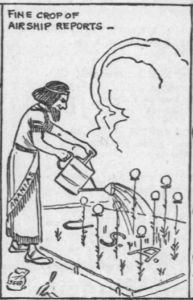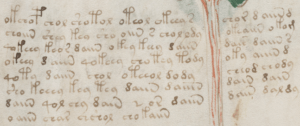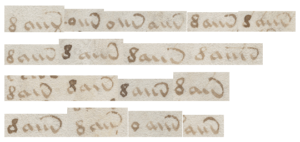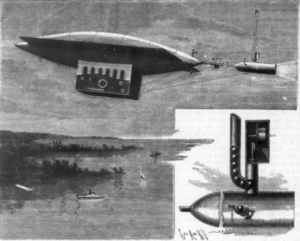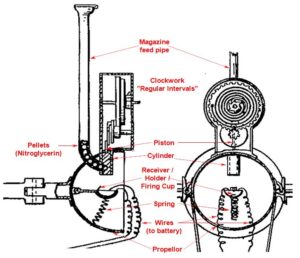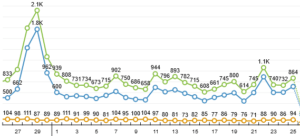You know, I’m so glad you asked me that question, it’s almost as if I was waiting to be asked.
It turns out that there were in fact two airship ciphers. Well… one. Well… none. Well… maybe a half.
Bear with me, I’ll try to explain.
The 1897 Aurora Alien Incident
Daniel Cohen has a lot of fun with this incident, to the point that it fills an entire chapter (Chapter 8, “The Texas Spaceship Crash“) of his “The Great Airship Mystery” book. This is because he gets a chance to tell a story that involves a whole load of UFO groups doing what they do best (or perhaps worst) – ripping into each other’s methodological, historical and evidential shortcomings, while displaying almost exactly the same ideological blindness and ineptitude themselves. It’s a story with Jacques Vallee, Dr. J. Allen Hynek, and a 1973 incident where the “spaceman’s grave” was robbed out. What’s there not to like?
The first airship cipher story originally appeared in the newspapers as follows:
A Windmill Demolishes It.
Aurora, Wise Co., Tex. April 17. – (To The News.) About 6 o’clock this morning the early risers of Aurora were astonished at the sudden appearance of the airship which has been sailing through the country.
It was travelling due north, and much nearer the earth than ever before. Evidently some of the machinery was out of order, for it was making a speed of only ten or twelve miles an hour and gradually settling toward the earth. It sailed directly over the public square, and when it reached the north part of town collided with the tower of judge Proctor’s windmill and went to pieces with a terrific explosion, scattering debris over several acres of ground, wrecking the windmill and water tank and destroying the judge’s flower garden.
The pilot of the ship is supposed to have been the only one on board, and while his remains are badly disfigured, enough of the original has been picked up to show that he was not an inhabitant of this world.
Mr. T.J. Weems, the United States signal service officer at this place and an authority on astronomy, gives it as his opinion that he was a native of the planet Mars.
Papers found on his person – evidently the records of his travels – are written in some unknown hieroglyphics, and can not be deciphered.
The ship was too badly wrecked to form any conclusion as to its construction or motive power. It was built of an unknown metal, resembling somewhat a mixture of aluminium and silver, and it must have weighed several tons.
The town is full of people to-day who are viewing the wreck and gathering specimens of the strange metal from the debris. The pilot’s funeral will take place at noon tomorrow.
For a cut-down re-telling of the whole sorry saga, you could high-tail it to the Wikipedia page: but Cohen leaves his readers in little doubt that it was a local hoax. So the “Papers found on [the alien pilot’s] person [… that] are written in some unknown hieroglyphics, and can not be deciphered” would seem to fall into the ‘outright hoax‘ category, along with the rest of the whole (non-existent windmill-height) tall tale.
The Astoria Cipher
The earliest newspaper appearance of the second airship cipher story I have found is from the Miners Journal of April 20 1897, which runs as follows:
FROM THE “AIR-SHIP”
A Letter Addressed to Edison Found in an Illinois Village.
Astoria, Ill., April 18. A great sensation was caused here to-day when it was learned that a message had been received from the alleged air ship.
“Bert” Swearingin found it on a farm one-half mile north of the town in a piece of reed about three feet long, sticking in the ground, with a red, white and blue streamer attached to the top.
An egg-shaped stone was tied by rags to the lower end, weighing about three pounds.
About half way to the top of the reed was attached a packet, enclosed in a large and dirty envelope, on which was written:
“From air ship. – Notice to the finder: Please mail letter inside. Passed over here about half-past 2 p. m., April 16, 1897, about 2,300 feet high, going east and north. Excuse dirt, as just got done oiling. “HARRIS”
The letter was addressed and ready for mailing to Thomas A. Edison, New York city. It was opened and found to be written in cipher, dated April 16, and signed “C. L. Harris, Electrician Air Ship No. 3.” It will be mailed. Captain James McNeill, Mrs Walters and other here declare they saw the ship last night.
This story fell on ears well-primed by the media. The Chicago Tribune of 16 Apr 1897 (p.4) had just printed a sighting from a fisherman of someone on the airship nearly catching a swordfish on a lake near Cleveland OH (errrm… the one that got away); by “more than a hundred persons” at Mount Vernon, IL; at Carlyle, IL travelling northwest in the evening; and at South Haven, MI, travelling westward. Having said that, I should add that the Tribune printed an Ananias-themed (Liars’ club) airship cartoon on the 18th, and an editorial comparing the airship to mythical sea serpents on the 20th, so was no big airship fan.
Anyhow, the newspapermen of the day immediately whooshed Harris’ enciphered letter to the great man himself in his West Orange Laboratory, who was… somewhat less than impressed, let us say. According to the Bucyrus Evening Telegraph of 5 May 1897 (p.3):
Mr. Edison paused from a luncheon of sandwiches, pumpkin pie and tea to observe: “You can take it from me that that is a pure fake. I have had several men in my employ called Harris, but I know nothing of C. L. Harris.
“I have no doubt that airships will be successfully constructed in the near future, but there has been too much talk about this supposed airship out west. I have always found that there is much talk before these ships are tried and very little afterward.
“It is absolutely absurd to imagine that a man would construct a successful airship and keep the matter secret. When I was young we used to construct big colored paper balloons, inflate them with gas, and they would float about for days. I guess some one has been up to that same game out west. […]”
Yes, yes, that’s all well and good, but… what about the bloomin’ cipher, then? In many ways, it now doesn’t matter if it’s really from an airship or not, it may well have genuinely been enciphered. Without seeing it, who’s to say what it said?
To that end, I tried searching the digital edition of the Thomas A. Edison papers at Rutgers, but found only a pair of newspaper clippings of the story (initially from the New York Herald of April 19 1897) and no cipher, alas; so it seems to be lost. If anyone has a better idea as to where to look for it, please say!
Summary
At the top, I promised you two, or one, or none, or “maybe a half” airship cipher, which is where I think this story is at. Perhaps one day the second cipher will turn up: I’ll be here waiting. Fingers crossed!
